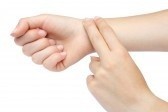Learning to take your pulse and interpret your results will help you identify and eliminate food and environmental allergies that can adversely affect the function of your thyroid gland. You can easily check your pulse on the inside of your wrist, below your thumb.
Instructions:
Gently place 2 fingers of your other hand on the artery. (See photo).
Do not use your thumb, because it has its own pulse that you may feel.
Count the beats for 30 seconds, and then double the result to get the number of beats per minute.
Results:
(A) If your daily maximal pulse is constant (within 1 or 2 beats) for 3 days in a row, you have avoided all “food sensitivities” for those days.
(B) If your pulse taken standing is greater than your pulse taken sitting, this is a positive indication of food or environmental sensitivity.
(C) If your daily maximal pulse varies more than 2 beats from day to day, you are “sensitive,” unless you have an infection.
(D) If your pulse increases more than 6 beats above your average normal maximum after eating a particular food or meal, you are sensitive to that food or something in that meal.
(E) If your minimum pulse rate does not regularly occur before rising, after your night’s rest, this can indicates that you are sensitive to dust, dust mites, or something else in your sleeping environment such as perfume, your mattress, your pillow, etc.








